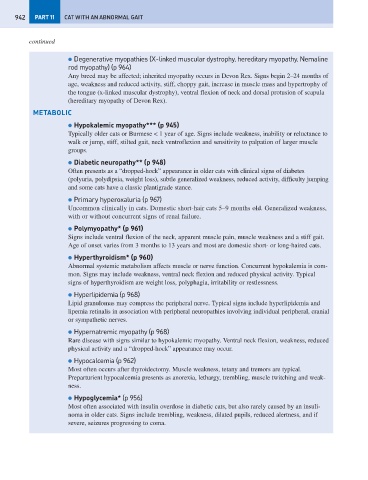Page 950 - Problem-Based Feline Medicine
P. 950
942 PART 11 CAT WITH AN ABNORMAL GAIT
continued
● Degenerative myopathies (X-linked muscular dystrophy, hereditary myopathy, Nemaline
rod myopathy) (p 964)
Any breed may be affected; inherited myopathy occurs in Devon Rex. Signs begin 2–24 months of
age, weakness and reduced activity, stiff, choppy gait, increase in muscle mass and hypertrophy of
the tongue (x-linked muscular dystrophy), ventral flexion of neck and dorsal protusion of scapula
(hereditary myopathy of Devon Rex).
METABOLIC
● Hypokalemic myopathy*** (p 945)
Typically older cats or Burmese < 1 year of age. Signs include weakness, inability or reluctance to
walk or jump, stiff, stilted gait, neck ventroflexion and sensitivity to palpation of larger muscle
groups.
● Diabetic neuropathy** (p 948)
Often presents as a “dropped-hock” appearance in older cats with clinical signs of diabetes
(polyuria, polydipsia, weight loss), subtle generalized weakness, reduced activity, difficulty jumping
and some cats have a classic plantigrade stance.
● Primary hyperoxaluria (p 967)
Uncommon clinically in cats. Domestic short-hair cats 5–9 months old. Generalized weakness,
with or without concurrent signs of renal failure.
● Polymyopathy* (p 961)
Signs include ventral flexion of the neck, apparent muscle pain, muscle weakness and a stiff gait.
Age of onset varies from 3 months to 13 years and most are domestic short- or long-haired cats.
● Hyperthyroidism* (p 960)
Abnormal systemic metabolism affects muscle or nerve function. Concurrent hypokalemia is com-
mon. Signs may include weakness, ventral neck flexion and reduced physical activity. Typical
signs of hyperthyroidism are weight loss, polyphagia, irritability or restlessness.
● Hyperlipidemia (p 968)
Lipid granulomas may compress the peripheral nerve. Typical signs include hyperlipidemia and
lipemia retinalis in association with peripheral neuropathies involving individual peripheral, cranial
or sympathetic nerves.
● Hypernatremic myopathy (p 968)
Rare disease with signs similar to hypokalemic myopathy. Ventral neck flexion, weakness, reduced
physical activity and a “dropped-hock” appearance may occur.
● Hypocalcemia (p 962)
Most often occurs after thyroidectomy. Muscle weakness, tetany and tremors are typical.
Preparturient hypocalcemia presents as anorexia, lethargy, trembling, muscle twitching and weak-
ness.
● Hypoglycemia* (p 956)
Most often associated with insulin overdose in diabetic cats, but also rarely caused by an insuli-
noma in older cats. Signs include trembling, weakness, dilated pupils, reduced alertness, and if
severe, seizures progressing to coma.

